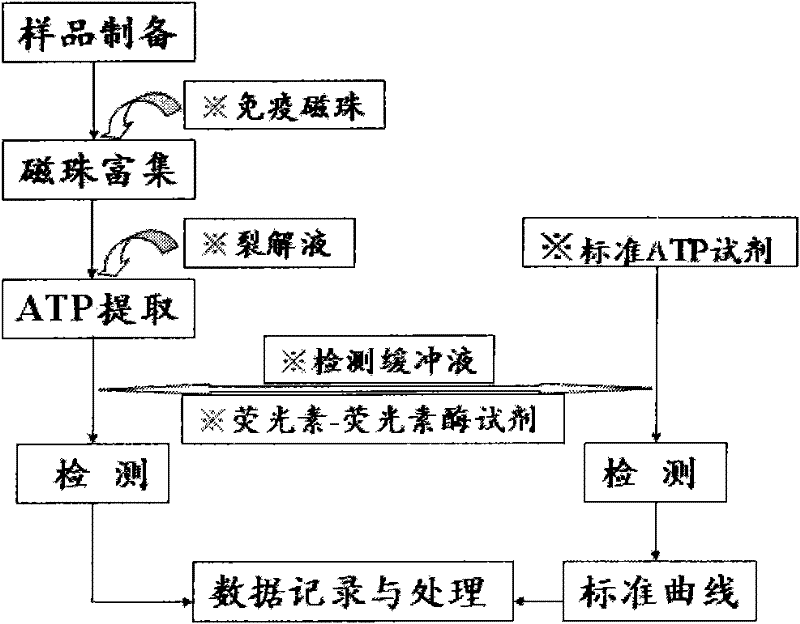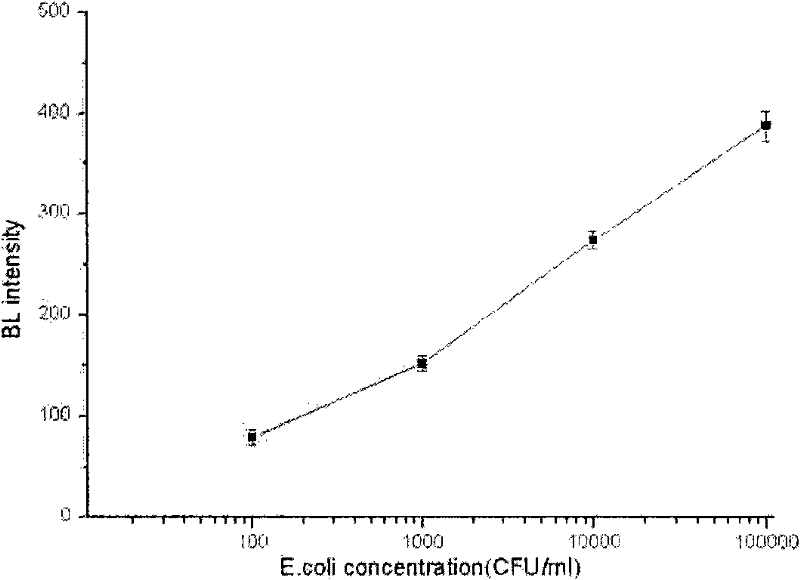Detection method and detection kit for detecting special pathogenic bacteria by bioluminescence
A bioluminescent, pathogenic bacteria technology, applied in the field of microbial detection, to achieve the effect of strong specificity, high sensitivity, and easy operation
- Summary
- Abstract
- Description
- Claims
- Application Information
AI Technical Summary
Problems solved by technology
Method used
Image
Examples
Embodiment 1
[0028] Example 1: Construction of the bioluminescence rapid detection E.coliO157:H7 kit
[0029] Bioluminescence rapid detection E.coliO157:H7 kit includes 5 bottles of immunomagnetic beads coated with antibodies, 100 μl in each bottle; standard ATP solution (1×10 -7 mol / l) 1 vial, 100 μl each; 1 vial of microbial lysate, 10 ml; 5 vials of detection buffer, 20 ml each; 5 vials of bioluminescence reagent, 1 ml each. Wherein, ① the preparation of reagents includes:
[0030] a) Immunomagnetic beads: Take 500μg of carboxyl magnetic beads in a 1.5ml centrifuge tube, add 1ml of washing buffer, mix well and sonicate for 15min, magnetically separate and wash twice, then resuspend in 250μl 2-(N-morpholino) Add 500 μg 1-ethyl-3-(3-dimethylaminopropyl)-carbodiimide (EDC) and 750 μg N-hydroxysuccinimide (NHS) to ethanesulfonic acid (MES), 37°C Activate the carboxyl groups on the surface of the magnetic beads for 15 minutes, then wash twice with MES, add 50ug of antibody after resuspensi...
Embodiment 2
[0035] Example 2: Detection of Escherichia coli O157:H7 in food using bioluminescent method rapid detection of special pathogenic bacteria kit
[0036] Adopt the detection kit in embodiment 1 to be used for the detection of embodiment 2
[0037] The schematic diagram of the detection process is as figure 1 shown. Specific steps are as follows:
[0038] a) Make a standard ATP curve first, that is, carry out equal dilution to the ATP standard, and the concentration range is 10 -12 -10 -7 mol / l. A bioluminescent agent is added for detection, and the relationship between the concentration of the ATP standard substance and its luminescence value is obtained.
[0039] b) The sample is then pretreated to prepare a suitable sample solution.
[0040] c) Add the immunomagnetic beads to the sample solution, incubate together, and remove the supernatant after sufficient binding.
[0041] d) adding a small amount of microbial lysate, and reacting at room temperature for 1 min.
[0...
PUM
 Login to View More
Login to View More Abstract
Description
Claims
Application Information
 Login to View More
Login to View More - R&D
- Intellectual Property
- Life Sciences
- Materials
- Tech Scout
- Unparalleled Data Quality
- Higher Quality Content
- 60% Fewer Hallucinations
Browse by: Latest US Patents, China's latest patents, Technical Efficacy Thesaurus, Application Domain, Technology Topic, Popular Technical Reports.
© 2025 PatSnap. All rights reserved.Legal|Privacy policy|Modern Slavery Act Transparency Statement|Sitemap|About US| Contact US: help@patsnap.com



